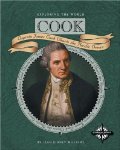Through the Looking Glass Children's Book Reviews
Captain James Cook Charts the Pacific Ocean
Nonfiction
For ages 7 to 9
Compass Point Books, 2003 ISBN: 978-0756504212
James Cook was the son of a farm manager. Luckily for Cook those who were able to help made it possible for him to get an education, and when he was a teenager he got a job in a shop in a seaport. The job did not hold Cook's attention for long however. It was the sea that he was really interested in and in 1746 he got himself a job working for a shipping business. He spent the next nine years learning everything he could about sailing and in 1755 he joined the Royal Navy.
By 1768 Cook was so well respected and experienced that he was chosen to lead a very important expedition to the island of Tahiti. The Royal Navy wanted to have Cook look for a continent which they thought existed somewhere in the Southern Hemisphere. They wanted him to do this in secret. He was to take a number of scientists with him. One would look at certain astronomical events which would be taking place at the time of the journey. A botanist would also be taken along and artists would record new species of plants and animals that were discovered.
Captain Cook was able to get his crew to Tahiti in one piece. Not only that but they were healthy when they arrived because he insisted that his ship was kept clean and because he fed his men well giving them foods that kept scurvy at bay. Soon Cook and the scientists were studying the flora and fauna, were taking astronomical observations, and Cook was making extensive maps of the island.
Cook then sailed on to look for the continent that the Royal Navy was sure was there. He sailed south as ordered and came to New Zealand which he sailed around for the next six months, mapping the coastline. Once this was complete he sailed again and reached Australia's east coast going ashore near where Sydney is today. The landing site was named Botany Bay because of all the fantastic plant species that were found there. Cook explored more of the coastline before heading for home. He left without fully realizing how large Australia was. He got back to England after being at sea for three years.
This was just the first of Cook?s three famous voyages. People in England were so impressed with what he had accomplished that he was promoted to commander and another trip was organized which left England in 1772. The search for the southern continent continued taking Cook into the Antarctic Circle, to New Zealand once more, and to Easter Island.
Cook's final journey was to look for a water passage which he hoped connected the Pacific and Atlantic oceans. Many explorers had sought in vain for this Northwest Passage. He left England with two ships in 1776 and headed for New Zealand. He then went on to Tahiti, Christmas Island, and the Hawaiian Islands. The latter two had never been visited by Europeans. It was in Hawaii, after having failed to find the Northwest passage, that things went wrong for Cook and his men. Cook and several of his sailors were killed by the local Hawaiians during an argument.
In this excellent book the author tells the story of James Cook in an interesting and engaging way. Maps and annotated illustrations break up the text giving young readers plenty to look at as they read about one of the most interesting explorers of all time. The author not only describes Cook?s great travels but she also emphasizes how much Cook changed the way sailors were treated because of Cook?s example.
This is one of the titles in the "Exploring the World" series.




